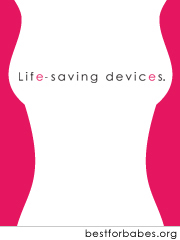The newborn infant has instincts and reflexes that, if appropriately stimulated, will lead him to latch and suckle at the breast with minimal effort. The breastfeeding parent also has instinctive responses to the infant’s reflex behaviors. A newborn infant, when placed on a parent’s bare chest, can even move to the breast, latch on and begin to suckle. Klaus (1998) A study that was designed to assess infant feeding reflexes, suggests that the initiation of breastfeeding is instinctive in both parent and infant. According to the results of this study, parents do not need to be taught to breastfeed and further, teaching may interfere with the instinctive behaviors which can help parent and infant to achieve an effective latch. Colson, Meek and Hawdon (2008)
Newborn infants are abdominal feeders and respond best to a position in which the parent reclines and infant is placed upright, against the parent’s chest. This position, referred to as biological nurturing, stimulates primitive neonatal reflexes (and instinctive responses from the parent) that support latching and feeding behaviors. Infants who latch on to the breast, while in this position, naturally achieve an asymmetrical latch (more areola showing at the upper lip than the lower) which is believed by many experienced clinicians, to be most conducive to effective milk transfer. It was determined that infants who are fed by a parentwho is in a more upright position, such as in a cradle hold, demonstrate less effective reflex behaviors that may even interfere with managing an effective latch. Colson et al. (2008)
To learn more, visit http://biologicalnurturing.com/
© Laura Spitzfaden 2010



